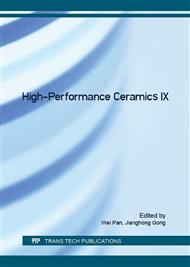[1]
M, Barsoum, T, El-Raghy, The MAX Phases: Unique New Carbide and Nitride Materials, Am. Sci. 89 (2001) 334-343.
DOI: 10.1511/2001.28.736
Google Scholar
[2]
J. E. Spanier, S. Gupta, M. Amer, M. W. Barsoum, Vibrational of the Mn+1AXn phases from first-order Raman scattering (M=Ti, V, Cr, A=Si, X=C, N), Phys. Rev. B. 71 (2005) 012103-012110.
Google Scholar
[3]
H. R. Ramay, M. Zhang, Preparation of porous hydroxyapatite scaffolds by combination of the gel-casting and polymer sponge methods, Biomater. 24 (2003) 3293-3302.
DOI: 10.1016/s0142-9612(03)00171-6
Google Scholar
[4]
Y. Enríquez Mendez, M. Vlasova, I. Leon, M. Kakazey, M. Dominguez-Patino, L. Isaeva, Low temperature synthesis of porous silicate ceramics, Sci. Sinter. 39 (2007) 39-49.
DOI: 10.2298/sos0701039m
Google Scholar
[5]
M. Cao, Q. Yan, X, Li, Y. Mi, Effect of plate-like alumina on the properties of alumina ceramics prepared by gel-casting, Mat. Sci. Eng. A. 589 (2014) 97-100.
DOI: 10.1016/j.msea.2013.09.061
Google Scholar
[6]
A. Alem, M. D. Pugh, R. A. L. W, Open-cell reaction bonded silicon nitride foams: Fabrication and characterization, J. Eur. Ceram. Soc. 34 (2014) 599-609.
DOI: 10.1016/j.jeurceramsoc.2013.09.011
Google Scholar
[7]
M. Zhou, L. Zeng, X. Cheng, H. Wang, Preparation of large effective specific surface area reticulate porous ceramics by polymeric foam replication process using recoating technique, Rare Met. 30 (2011) 418-421.
DOI: 10.1007/s12598-011-0316-3
Google Scholar
[8]
A. Fadli, I. Sopyan, Porous Alumina through Protein Foaming-Consolidation Method: Effect of Stirring Time and Drying Temperature on the Physical Properties, Adv. Mater. Res. 93-94 (2010) 397-400.
DOI: 10.4028/www.scientific.net/amr.93-94.397
Google Scholar
[9]
T. M. G. Chu, J. W. Halloran, S. J. Hollister, S.E. Feinberg, Hydroxyapatite implants with designed internal architecture, J. Mater. Sci. Mater. Med. 12 (2001) 471-8.
Google Scholar
[10]
H. R. Ramay, M. Zhang, Preparation of porous hydroxyapatite scaffolds by combination of the gel-casting and polymer sponge methods, Biomater. 24(2002) 3293-3302.
DOI: 10.1016/s0142-9612(03)00171-6
Google Scholar
[11]
P. Sepulveda, J. G. P Binner, S. O. Rogero, et al., Production of porous hydroxyapatite by the gel-casting of foams and cytotoxic evalution, J. Biomed. Mater. Res. 50 (2000) 27-34.
DOI: 10.1002/(sici)1097-4636(200004)50:1<27::aid-jbm5>3.0.co;2-6
Google Scholar
[12]
X. Zhu, D. Jiang, S. Tan, Preparation of Silicon Carbide Reticulated Porous Ceramics, Mater. Sci. Eng. A 323 (2002) 232–238.
DOI: 10.1016/s0921-5093(01)01352-1
Google Scholar
[13]
C. Tian, J. S Zhang, X. M. Cao, Q. liu, W. P. Hu, High strength silicon carbide foams and their deformation behavior, J. Mater. Sci. Technol. 22 (2006) 269-272.
Google Scholar
[14]
M. Yan, Y. L. Chen, B. C. Mei, J. Q. Zhu, Synthesis of high-purity Ti2AlN ceramic by hot pressing, Trans. Nonferrous Met. Soc. China 18 (2008) 82-85.
DOI: 10.1016/s1003-6326(08)60015-1
Google Scholar
[15]
M. H. Amini, T. W. Coyle, T. Sinclair, Porous ceramics as backing element for high-temperature transducers, IEEE T. Ultrason. Ferr. 62 (2015) 360-372.
DOI: 10.1109/tuffc.2014.006711
Google Scholar
[16]
M. Yan, Y. L. Chen, Y. Chang, J. X. Jiang, Synthesis of High-purity Dense Ti2AlN Ceramic and Its High Temperature performance, Mat. Rev. 26 (2012) 102-113.
Google Scholar
[17]
H. S. Li, Wijn. J. R. De, P. Layrolle, G. K. De, Synthesis of macroporous hydroxyapatite scaffolds for bone tissue engineering, J. Biomed. Mater. Res. 61 (2002) 109-20.
DOI: 10.1002/jbm.10163
Google Scholar


